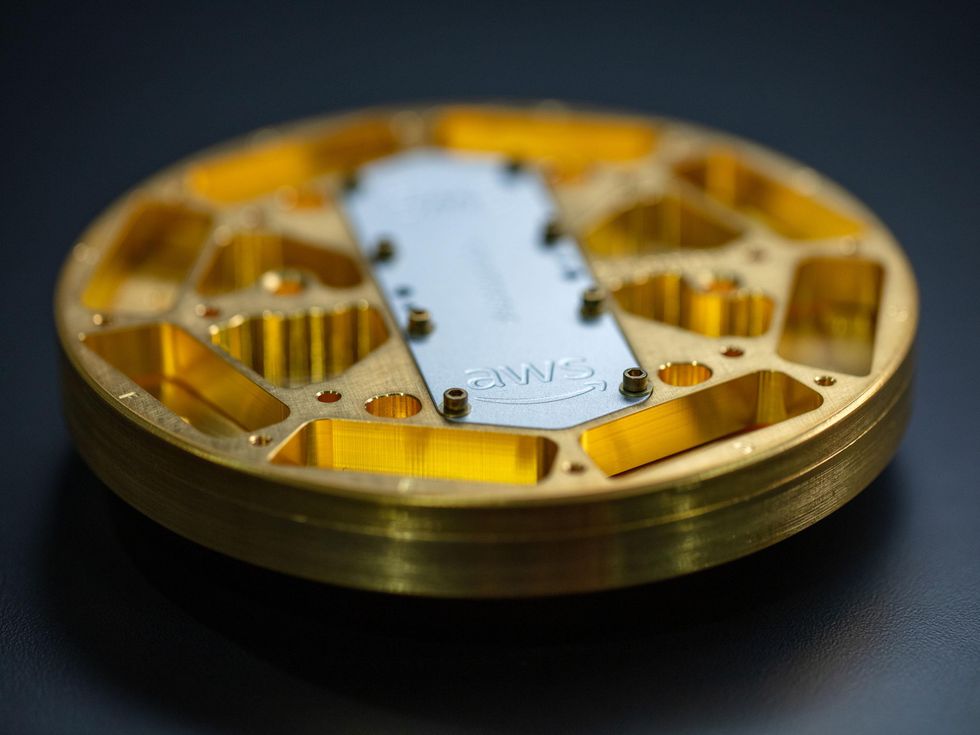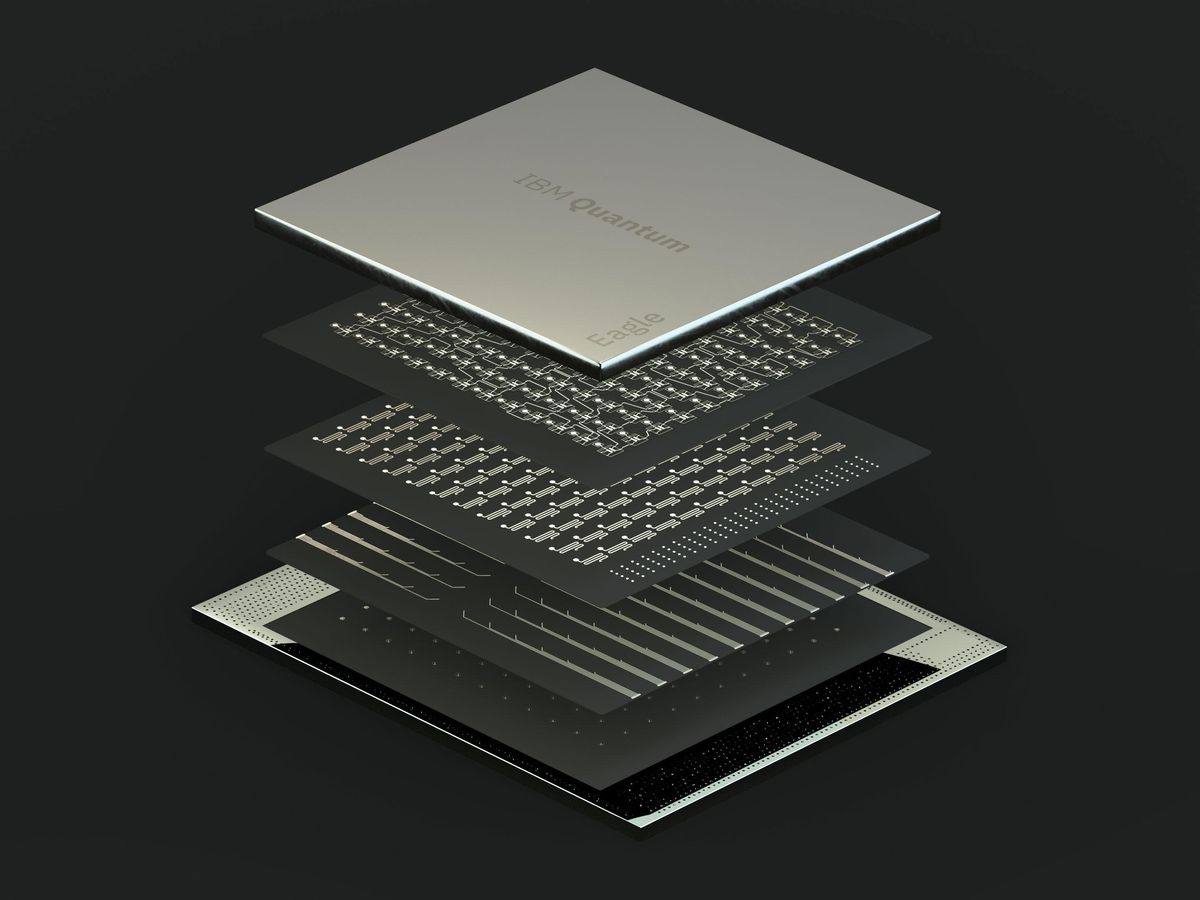Quantum computers are theoretically far more powerful than classical computers on important tasks such as investigating novel battery designs or discovering new drugs, but they are currently too error prone for practical use. Now Amazon, Google, IBM, and others are pursuing a bevy of innovative strategies to develop fault-tolerant quantum computers based on superconducting circuits.
Whereas classical computers switch transistors either on or off to symbolize data as ones or zeroes, quantum computers use quantum bits, or "qubits," which because of the surreal nature of quantum physics can exist in a state of superposition where they are both 1 and 0 at the same time. This essentially lets each qubit perform two calculations at once. The more qubits that are quantum-mechanically linked, or entangled, the more calculations they can perform simultaneously.
Present-day state-of-the-art quantum computers typically suffer roughly one error every 1,000 operations. Many practical applications demand error rates lower by a billionfold or more, says Oskar Painter, head of Amazon Web Services' (AWS) quantum-hardware program and an experimental physicist at the California Institute of Technology.
In addition to building qubits that are physically less prone to mistakes, scientists often hope to compensate for high error rates by spreading quantum information across many redundant qubits. This would help quantum computers detect and correct errors, so that a cluster of a thousand or so "physical qubits," the kinds that researchers have developed to date, can make up one useful "logical qubit." Many tech giants aim to develop fault-tolerant quantum computers using superconducting circuits as qubits because such hardware is scalable to thousands of physical qubits in the near future, Painter says.
Amazon's Schrödinger's Cats
One strategy Amazon is exploring to build a fault-tolerant quantum computer involves machines that are inherently stable against error. The key is a hardware version of Schrödinger's cat—the thought experiment in which a cat in a box is suspended in a fuzzy state between life and death—until someone looks in the box and the cat is then either living or dead.
Scientists can theoretically encode data in a qubit using virtually any pair of states of a quantum system—for instance, two of a molecule's potentially many different energy levels. Amazon researchers are investigating using so-called cat states, a pair of states as opposed to one another as the states of life and death experienced by Schrödinger's hypothetical cat.
Specifically, Amazon's design relies on an oscillator whose fluctuations move in phase. Its cat states rely on pairs of fluctuations with opposite phases in the same oscillator. Painter and his colleagues found they could make cat qubits that are highly resistant to bit flip, where a qubit flips from one state to another, one of two main sources of error a superconducting qubit can have.

"One of the biggest challenges today when it comes to superconducting quantum computing is reducing bit flip," Painter says. Bit flips result from environmental noise, such as spikes of heat or electricity, so using cat qubits can help protect a quantum computer against outside disruption, he notes.
This strategy does make cat qubits more vulnerable to the other common source of error a superconducting qubit can have, known as phase flip, where it switches between one of two opposite phases. However, Amazon says it can then use quantum error-correction schemes to compensate for phase flips. Focusing on just one kind of error instead of two "reduces the overhead resources you need for quantum computing by a factor of a square root," Painter says. This can readily amount to orders of magnitude fewer physical qubits needed.
At the AWS re:Invent conference in December, Painter and his colleagues described research on cat qubits that were roughly 20,000 times as biased toward bit flip than phase flip. "That's a big, big step forward," he notes. Within the next year, they hope to reveal a logical qubit based on cat qubits, he adds.
Google's Codes
In theory, using more physical qubits can result in an exponential suppression of quantum-computing error rates. Google recently showed this was possible using its 54-qubit Sycamore quantum computer, which in 2019 carried out a calculation in 200 seconds that the company estimated would take Summit, the world's most powerful supercomputer at that time, 10,000 years.
Google had physical qubits serve either as "data qubits" that encode the logical qubit or "measure qubits" tasked with repeatedly detecting errors in their fellow qubits. When the qubits were arranged in a one-dimensional chain, with each qubit having two neighbors at most, increasing the number of qubits led to an exponential suppression of the rate of bit or phase-flip errors, reducing the amount of errors per round of detections and corrections up to more than a hundredfold when they scaled up the number of qubits from 5 to 21.
However, quantum errors are not limited to just one direction. But when Google researchers used a "surface code," in which they arranged the qubits in a two-dimensional checkerboard pattern, they found that such a design using data and measure qubits performed as expected from computer simulations.
In subsequent work, Google tested how a different two-dimensional qubit grid could help develop lower-error qubits. They employed 31 data qubits on Sycamore to run a "toric code"—so named because it mimics a lattice placed on the surface of a torus—to simulate exotic two-dimensional quasiparticles known as anyons. Anyons are collective excitations not associated with any one qubit, "sort of like how a crowd can do 'the wave' and the wave isn't associated with any particular person," says Kevin Satzinger, a research scientist at Google.
Pairs of anyons can "braid," or swap places. Braiding means that anyons can in a sense remember how they behaved with respect to one another even after they get separated. A "topological qubit" created from pairs of anyons could benefit from a kind of protection conveyed by its topology, defending it from disruptions and reducing error rates.
IBM's Hexagons
Instead of arranging its qubits in square grids, IBM arrays its qubits in hexagonal lattices, with a qubit on each point and another on each flat edge. This pattern, now used in all the company's quantum computers—including its 127-qubit Eagle quantum processor—can reduce potential errors caused by accidental interactions between neighboring qubits. "Each qubit has only two or at most three neighboring qubits," says Sarah Sheldon, a quantum physicist at IBM. (In comparison, in square grids, a qubit may have up to four neighbors.)
IBM believes this new layout will help it scale up faster to much larger practical quantum computers. The company aims to debut its 1,121-qubit Condor processor in 2023.
This architecture does require new quantum error-correction codes adapted to hexagons instead of squares, which IBM is actively researching. Recent work from IBM suggests quantum error-correction codes adapted to hexagons "can lead to a significant reduction in error rates," says Sheldon.
In addition to actively correcting errors, IBM is exploring error-mitigation schemes to avoid them in the first place. One strategy, zero-noise extrapolation, confronts how quantum computers are typically very sensitive to disruptions from noise in their environment. By repeating quantum computations at varying levels of noise, the researchers can extrapolate what the quantum computer would calculate in the absence of noise.
"We've scaled this method to quantum circuits using 26 qubits and have shown it has promise to improve quantum simulations in the near future," Sheldon says. "Ultimately, building a fault-tolerant quantum computer is going to require implementing error correction, but as we build towards that, error mitigation can prove of substantial aid in the near term."
Ancillas and Magic States
Even if quantum computers do scale up to many thousands of physical qubits to potentially support enough logical qubits for practical applications, they will have to deal with another major challenge—the need for extra "ancilla qubits," Painter says.
When two logical qubits are connected in a quantum logic gate—an elementary operation that quantum computers use to perform a computation—scientists want to make sure that each physical qubit in a logical qubit interacts with only one physical qubit in the other logical qubit. This limits the disruption that could happen if a physical qubit experienced an error. Doing so requires ancilla qubits to monitor potential errors, "which counts as additional overhead," Painter says.
The special quantum states in which qubits can serve as ancillas are known as "magic states," and preparing them requires particular hardware dubbed magic-state factories. "No one is even close to making a magic-state factory that works efficiently," Painter says. "It's a grand challenge for the entire industry."
In a 2020 study, Amazon did suggest a way to reduce the number of ancilla qubits needed by at least an order of magnitude. This strategy involves using ancilla qubits not just to detect errors but also events where minor errors grow to major uncorrectable errors. This also reduces the amount of resources needed in terms of magic-state factories.
Amazon, IBM, and others continue to work on magic-state factories. "Once we demonstrate error correction on a logical qubit, then we will have all the building blocks we need to demonstrate magic states," Painter says.
Correction (4 Feb. 2022): An earlier version of this story attributed a quote to Jimmy Chen at Google, when in fact the quote was from Kevin Satzinger, also a research scientist on the Google AI Quantum hardware team.
- How Much Has Quantum Computing Actually Advanced? - IEEE ... ›
- For Quantum Computing, Is 99 Percent Accuracy Enough? - IEEE ... ›
- Google's Quantum Computer Exponentially Suppresses Errors ... ›
- Quantum Computer Error Correction Is Getting Practical - IEEE ... ›
- How to Build a Fault-Tolerant Quantum Computer - IEEE Spectrum ›
- Quantum Error Correction: Time to Make It Work - IEEE Spectrum ›
- "Qudit" Computers Go Beyond Ones and Zeroes - IEEE Spectrum ›
- How Tiny Schrödinger’s Cats Could Upend Quantum Again - IEEE Spectrum ›
- Here Are 6 Actual Uses for Near-Term Quantum Computers - IEEE Spectrum ›
- Quantinuum Successfully Teleports a Logical Qubit - IEEE Spectrum ›
Charles Q. Choi is a science reporter who contributes regularly to IEEE Spectrum. He has written for Scientific American, The New York Times, Wired, and Science, among others.



